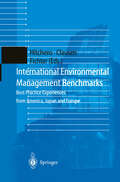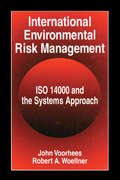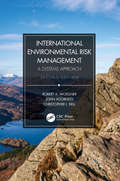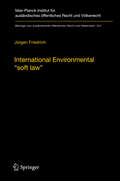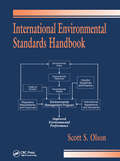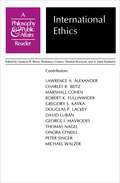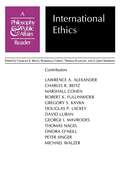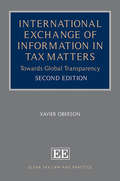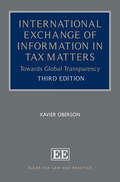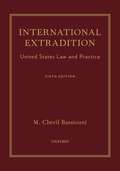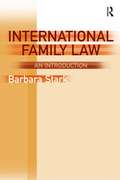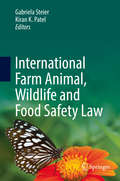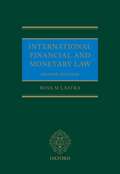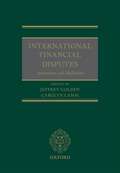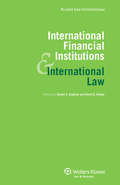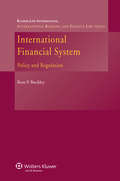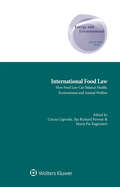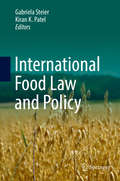- Table View
- List View
International Environmental Management Benchmarks: Best Practice Experiences from America, Japan and Europe
by Prof. Dipl. Ing. Dipl. ÖkonomThis book shows what sustainable development means for the business community and presents best practice approaches in environmental management from Japan, the USA, Brazil and seven European countries. It stresses that international competitiveness depends on the effective use of innovative management tools and has to be supported by an intelligent system of environmental regulation. Experts with many years of practical experience share their knowledge of how to achieve excellency in environmental performance, and present concrete steps towards a sustainable company.
International Environmental Risk Management: ISO 14000 and the Systems Approach
by John Voorhees Robert A. WoellnerInternational Environmental Risk Management: ISO 14000 and the Systems Approach gives readers an extensive analysis of practical applications of ISO 14000 and environmental compliance management systems. It offers a mixture of technical engineering advice, legal guidance, and common-sense business acumen. The authors explain the essentials of the standards - how they are being developed and what implications they present - and then discuss cost-benefit analyses, integration strategies, business risk control measures, litigation avoidance and legal expense reduction, and step-by-step guidance on achieving third-party certification.
International Environmental Risk Management: ISO 14000 and the Systems Approach
by John Voorhees Robert A. WoellnerInternational Environmental Risk Management: ISO 14000 and the Systems Approach gives readers an extensive analysis of practical applications of ISO 14000 and environmental compliance management systems. It offers a mixture of technical engineering advice, legal guidance, and common-sense business acumen. The authors explain the essentials of the standards - how they are being developed and what implications they present - and then discuss cost-benefit analyses, integration strategies, business risk control measures, litigation avoidance and legal expense reduction, and step-by-step guidance on achieving third-party certification.
International Environmental Risk Management: A Systems Approach
by Robert A. Woellner John Voorhees Christopher L. BellBased on the first edition with extensive analysis of practical applications of environmental risk management and compliance management systems, this second edition of International Environmental Risk Management reflects updates made in the understanding and application of risk management best practices and makes available a frame of reference and systematic approach to environmental and social governance (ESG). It provides a pathway for readers to implement environmental management strategies that can be integrated with core operations and other risk management efforts, including supporting sustainability and corporate social responsibility initiatives associated with climate change, the circular economy or supply chain conditions, as well as enterprise risk management; anti-bribery, and other compliance management systems. This book provides in-depth discussions of ways to use global environmental management standards. New features in this edition: Combines EMS standards with discussion of specific principles, other authors’ research, and guidelines on management practices. Provides guidelines on how to prepare for, anticipate, and resolve environmental issues. Includes easily understandable information for all readers and is not simply aimed toward individuals who are knowledgeable about this topic. Provides in-depth discussions on using global environmental management standards to manage risk and promote resilience, as well as legal strategies and voluntary initiatives that companies can utilize to minimize risk. Accounts for the substantive revisions in ISO 14001:2015. As a growing and rapidly changing field, it is necessary to address new issues, guidelines, and regulations to assist businesses, academia, students, consultants, lawyers, and environmental managers with a pragmatic resolution to environmental risk management issues. This second edition gives a broad and detailed analysis of the changes made to international standards and practices and serves as an excellent guide to managing environmental risk.
International Environmental Risk Management: A Systems Approach
by Robert A. Woellner John Voorhees Christopher L. BellBased on the first edition with extensive analysis of practical applications of environmental risk management and compliance management systems, this second edition of International Environmental Risk Management reflects updates made in the understanding and application of risk management best practices and makes available a frame of reference and systematic approach to environmental and social governance (ESG). It provides a pathway for readers to implement environmental management strategies that can be integrated with core operations and other risk management efforts, including supporting sustainability and corporate social responsibility initiatives associated with climate change, the circular economy or supply chain conditions, as well as enterprise risk management; anti-bribery, and other compliance management systems. This book provides in-depth discussions of ways to use global environmental management standards. New features in this edition: Combines EMS standards with discussion of specific principles, other authors’ research, and guidelines on management practices. Provides guidelines on how to prepare for, anticipate, and resolve environmental issues. Includes easily understandable information for all readers and is not simply aimed toward individuals who are knowledgeable about this topic. Provides in-depth discussions on using global environmental management standards to manage risk and promote resilience, as well as legal strategies and voluntary initiatives that companies can utilize to minimize risk. Accounts for the substantive revisions in ISO 14001:2015. As a growing and rapidly changing field, it is necessary to address new issues, guidelines, and regulations to assist businesses, academia, students, consultants, lawyers, and environmental managers with a pragmatic resolution to environmental risk management issues. This second edition gives a broad and detailed analysis of the changes made to international standards and practices and serves as an excellent guide to managing environmental risk.
International Environmental “soft law”: The Functions and Limits of Nonbinding Instruments in International Environmental Governance and Law (Beiträge zum ausländischen öffentlichen Recht und Völkerrecht #247)
by Jürgen FriedrichIn international negotiations, the question of the design and the legal form of the negotiated instrument is as complex as it is often controversial. Intended as a read for both practitioners and academics, this book provides a comprehensive treatise of the characteristics, the potential and the limits of nonbinding instruments in international environmental law and governance. An extensive overview and typology of nonbinding instruments as well as several case studies from the areas of fisheries (FAO), hazardous substances (UNEP/FAO) and corporate social responsibility (OECD) provide the material for an in-depth analysis of the role of nonbinding instruments on all levels of governance. The book demonstrates the potential but also highlights the limits of nonbinding instruments in the interplay with customary and treaty law (e.g. UNCLOS, WTO) as bases for interinstitutional linkages and as tools to shape the behaviour of states and private actors. Legitimacy challenges arising from this form of exercise of authority are then discussed in the final chapter, alongside with remedies to address possible concerns.
International Environmental Standards Handbook
by Scott S. OlsonLack of knowledge about, and noncompliance with, international standards can result in loss of sales and partnership opportunities as well as possible legal action. The International Environmental Standards Handbook provides the necessary historical background to understand the current status of international environmental standards. It contains copies of available treaties and provides coverage of laws and standards. The book offers strategies for designing and implementing environmental systems that will be internationally accepted. It includes a list of information sources and a directory of international environmental organizations.
International Environmental Standards Handbook
by Scott S. OlsonLack of knowledge about, and noncompliance with, international standards can result in loss of sales and partnership opportunities as well as possible legal action. The International Environmental Standards Handbook provides the necessary historical background to understand the current status of international environmental standards. It contains copies of available treaties and provides coverage of laws and standards. The book offers strategies for designing and implementing environmental systems that will be internationally accepted. It includes a list of information sources and a directory of international environmental organizations.
International Ethics: A Philosophy and Public Affairs Reader (Philosophy and Public Affairs Readers #3)
by Lawrence A. AlexanderThis book is comprised of essays previously published in Philosophy & Public Affairs and also an extended excerpt from Michael Walzer's Just and Unjust Wars.
International Ethics: A "Philosophy and Public Affairs" Reader
by Lawrence A. Alexander Charles R. BeitzThis book is comprised of essays previously published in Philosophy & Public Affairs and also an extended excerpt from Michael Walzer's Just and Unjust Wars.
International Exchange of Information in Tax Matters: Towards Global Transparency, Second Edition (Elgar Tax Law and Practice series)
by Xavier ObersonIn this updated second edition, Xavier Oberson provides an authoritative overview of the instruments and models used to exchange information in tax matters on an international level. This book addresses the latest developments in the movement towards increased global transparency in tax matters and highlights how various international models interact. Key features of the second edition include: • Analysis of the OECD common reporting standard of automatic exchange of information • Definition of the various rights, substantial and procedural, that can be used during different phases of information exchange • Discussion on a range of international instruments and models including: double taxation treaties, TIEAs, the OECD multinational convention, European Directives, FATCA and the Swiss Rubik model • Examination of the impact of the OECD Base Erosion and Profit Shifting (BEPS) Program. Lawyers and tax specialists looking to further their knowledge will find this book to be an invaluable reference. Professionals in banking and finance will find this to be an informative read. Students and academics in law, tax and economics will appreciate the clear overview and find many useful insights.
International Exchange of Information in Tax Matters: Towards Global Transparency (Elgar Tax Law and Practice series)
by Xavier ObersonIn this thoroughly revised third edition of what has become the standard work on information exchange in tax matters, Xavier Oberson provides an authoritative overview of the instruments and models used to exchange information on an international level. Addressing the latest developments in the movement towards increased global transparency in tax matters, this updated edition also includes new rules of information exchanges and reporting on digital platforms, crypto assets and crypto currencies.Key Features:Analysis of the OECD Common Reporting Standard of automatic exchange of informationDiscussion on a range of international instruments and models including: double taxation treaties, TIEAs, the OECD multinational convention, European Directives, FATCA and the Swiss Rubik modelExamination of the new rules for information reporting to digital platforms and new reporting obligations for crypto-assets and e-money of the OECD Base Erosion and Profit Shifting (BEPS) ProgrammeLawyers, tax specialists and professionals in banking and finance looking to further their knowledge and gain insights into new developments in digital platforms and crypto currencies will find this book to be an invaluable reference. Students and academics in law, tax and economics will appreciate the clear overview and find this an essential resource.
International Extradition: United States Law and Practice
by M. Cherif BassiouniThis comprehensive guide covers all aspects of extradition to and from the United States, while making critical, theoretical, and practical evaluations of these aspects, and proposing alternatives. The rights of individuals, balancing of states interests, and preservation of world order within the Rule of Law form the conceptual framework of this book. The focus within U.S. practice explores the essentials involved in the executive branches treaty-making power, as implemented through its foreign relations practice, and as scrutinized by the judiciary. The Sixth Edition updates the treaties, laws, and cases cited with new content, including comparative material dealing with the European Union, cases involving the United States decided by other countries, and major decisions of the high courts of the UK, Canada, France, South Africa, Australia, Israel, Italy, and Germany. As with the prior editions, the Sixth Edition continues to expose certain questionable practices of the United States with regards to extradition.
International Family Law: An Introduction
by Barbara StarkInternational law has become part of everyday family law practice, as lawyers everywhere are confronted with questions regarding the rights of 'mail-order' brides, the adoption of children from other countries, the abduction of children by foreign parents, and domestic violence victims seeking asylum. Indeed, globalization is transforming family law, even as families themselves are being redefined. This book provides a practical overview of such issues and also examines the ways in which culture shapes family law in different countries. It provides students with a useful introduction to challenging, complicated and fascinating issues in international family law. Finally, by incorporating a comparative perspective, it gives readers an opportunity to re-examine their own legal systems.
International Family Law: An Introduction
by Barbara StarkInternational law has become part of everyday family law practice, as lawyers everywhere are confronted with questions regarding the rights of 'mail-order' brides, the adoption of children from other countries, the abduction of children by foreign parents, and domestic violence victims seeking asylum. Indeed, globalization is transforming family law, even as families themselves are being redefined. This book provides a practical overview of such issues and also examines the ways in which culture shapes family law in different countries. It provides students with a useful introduction to challenging, complicated and fascinating issues in international family law. Finally, by incorporating a comparative perspective, it gives readers an opportunity to re-examine their own legal systems.
International Farm Animal, Wildlife and Food Safety Law
by Gabriela Steier Kiran K. PatelThis volume is an inspiring and breakthrough piece of academic scholarship and the first of its kind featuring a comprehensive reader-friendly approach to teach the intricacies of the various aspects of international farm animal, wildlife conservation, food safety and environmental protection law. The selected focus areas are grouped in sections, such as agrobiodiversity, fishing and aquaculture, pollinators and pesticides, soil management, industrial animal production and transportation, and international food trade. Farm animal welfare, environmental protection, biodiversity conservation, and food safety are the core of the selected chapters. Every chapter provides real-world examples to make the complex field easy to understand.With its systematic approach, this book is devoted to anyone interested in the subject, becomes a valuable resource for professionals working in food regulation, and provides a solid foundation for courses and master’s programs in animal law, environmental policy, food and agriculture law, and regulation of these subjects around the world. Through its emphasis on sustainable food production, this work offers a cutting-edge selection of evolving topics at the heart of the pertinent discourse. As one of its highlights, this books also provides “Tools for Change,” a unique compilation and analysis of laws from the major farm animal product trading nations. With these tools, practitioners, advocates, policy makers and other state-holders are equipped with information to start work toward improving farm animal welfare, wildlife conservation, and food safety through the use of law and policy.
International Financial and Monetary Law
by Rosa LastraThis book is a leading authority on central banking and financial regulation, including detailed legal and policy analysis of the institutions that safeguard monetary stability and financial stability nationally, at the EU level and globally. The new edition has been renamed (previously 'Legal Foundations of International Monetary Stability') to better reflect the book's breadth of coverage, which includes an in-depth study of central banking, a fresh look at supervision, regulation and crisis management after the global financial crisis. It also includes updated material on the law of the European Central Bank and banking union, the law of the IMF and work undertaken by international standard-setters, in particular the FSB and the Basel Committee. Part I focuses on national developments, Part II deals with EU developments and Part III examines international developments. Each of these sections commences with a historical chapter, then analyses the framework of the 'monetary architecture'. Finally, each part considers the 'financial architecture' with regard to the functions of financial supervision (micro and macro) and surveillance, regulation and crisis management, including lender of last resort and resolution.
International Financial and Monetary Law
by Rosa LastraThis book is a leading authority on central banking and financial regulation, including detailed legal and policy analysis of the institutions that safeguard monetary stability and financial stability nationally, at the EU level and globally. The new edition has been renamed (previously 'Legal Foundations of International Monetary Stability') to better reflect the book's breadth of coverage, which includes an in-depth study of central banking, a fresh look at supervision, regulation and crisis management after the global financial crisis. It also includes updated material on the law of the European Central Bank and banking union, the law of the IMF and work undertaken by international standard-setters, in particular the FSB and the Basel Committee. Part I focuses on national developments, Part II deals with EU developments and Part III examines international developments. Each of these sections commences with a historical chapter, then analyses the framework of the 'monetary architecture'. Finally, each part considers the 'financial architecture' with regard to the functions of financial supervision (micro and macro) and surveillance, regulation and crisis management, including lender of last resort and resolution.
International Financial Disputes: Arbitration and Mediation
by Jeffrey Golden and Carolyn LammThis book provides the only specialist work on the arbitration of international financial disputes. The work covers commercial and investment arbitrations and considers the merits of and relationship between the various types of dispute resolution (mediation, arbitration and litigation). International arbitration is a growth area and financial disputes have been a consequence of the financial crisis. The need for more specialist knowledge during the conduct of disputes involving complex financial instruments has become particularly apparent in recent years. This book explains the various financial products including debt and equity instruments, currencies, commodities, derivatives and Islamic instruments and provides guidance on how to draft arbitration clauses with these products in mind. In the part on theories of liability, the issues of applicable law, expropriation, discrimination, fair and equitable treatment, and umbrella clauses are explained. There are separate chapters on remedies and choice of law, in addition to the more procedural aspects of enforcement and expert witness. The interplay between mediation and arbitration is analysed and explained. This is a key reference tool for all practising lawyers and arbitrators advising on disputes where financial products are involved. Drawing together some of the leading names in this specialist field the work provides some of the best and most recent analysis of law and practice relevant to such disputes.
International Financial Disputes: Arbitration and Mediation
This book provides the only specialist work on the arbitration of international financial disputes. The work covers commercial and investment arbitrations and considers the merits of and relationship between the various types of dispute resolution (mediation, arbitration and litigation). International arbitration is a growth area and financial disputes have been a consequence of the financial crisis. The need for more specialist knowledge during the conduct of disputes involving complex financial instruments has become particularly apparent in recent years. This book explains the various financial products including debt and equity instruments, currencies, commodities, derivatives and Islamic instruments and provides guidance on how to draft arbitration clauses with these products in mind. In the part on theories of liability, the issues of applicable law, expropriation, discrimination, fair and equitable treatment, and umbrella clauses are explained. There are separate chapters on remedies and choice of law, in addition to the more procedural aspects of enforcement and expert witness. The interplay between mediation and arbitration is analysed and explained. This is a key reference tool for all practising lawyers and arbitrators advising on disputes where financial products are involved. Drawing together some of the leading names in this specialist field the work provides some of the best and most recent analysis of law and practice relevant to such disputes.
International Financial Institutions and International Law
by Daniel D. Bradlow and David B. HunterFive essays set out the general principles of international law that are applicable to the IFIs and consider how these are or should be evolving to produce IFIs that are respectful subjects of international law and accountable to all relevant stakeholders for their compliance with international law. Six more focus on selected aspects of the IFIs’ operations that both raise important and challenging international legal issues and that have substantial impacts on both the different stakeholders in the operations of the IFIs, and on the sustainability and success of the operations. Introductory and concluding essays frame the volume. The many issues raised include the following: • IFIs’ impact on economic policies in Member States; • IFI operations as private financial transactions; • IFIs as key players in the creation of international law; • IFIs as promoters of the international capitalist system; • IFIs as bearers of human rights obligations under international human rights law or as participants in the UN system; • consequences of an IFI’s breach of its own internal policies or directives; • IFI immunity; • IFI capacity to sue and to be sued in national courts; • ability of various claimants to sue IFIs in domestic courts; • environmental and social rights and interests of third parties affected by IFI financing; • right of indigenous people to give their free, prior, and informed consent to IFI operations that affect them; and • IFIs’ treatment of workers’ rights.
International Financial System: Policy and Regulation
by Ross P. BuckleyIn a powerful demonstration of how we can learn from history, Professor Buckley provides deep analyses of some of the devastating financial crises of the last quarter-century. He shows how such factors as the origins and destinations of loans, bank behaviour, bad timing, ignorance of history, trade regimes, capital flight, and corruption coalesce under certain circumstances to trigger a financial crash. He then offers well-thought out legal measures to regulate these factors in a way that can prevent the worst from happening and more adequately protect the interests of vulnerable parties and victims. In the course of the discussion he covers such topics as the following: the roles of the Bretton Woods institutions in the globalisation process global capital flows debtor nation policies the effects of the Brady restructurings of the 80s and 90s fixed versus floating exchange rates the social costs of IMF policies debt-for-development exchanges and the national balance sheet problem. Professor Buckley’s far-reaching recommendations include details of tax, regulatory, banking, and bankruptcy regimes to be instituted at a global level.
International Food Law: How Food Law can Balance Health, Environment and Animal Welfare (Energy and Environmental Law and Policy Series #40)
by Cinzia Caporale Ilja Richard Pavone Maria Pia Ragionieriestation, habitat destruction and zoonoses; food naming and labelling; and food risk management. Throughout there is reference to an abundance of legislation, treaties, conventions, and case law at domestic, regional, and international levels, with particular attention to European, US, and World Trade Organization law and the work of the FAO. The book clearly demonstrates the necessity for reform of the global system of food production in the direction of a more sustainable and environment-friendly model. In its authoritative discussion of the relations among fields of law that are rarely discussed together – food law and the environment, food law and human rights, food law and animal welfare – this collection of chapters will prove a valuable resource both for officials working in food governance and security and for lawyers and scholars concerned with environmental management, sustainable development, and human rights around the world.
International Food Law and Policy
by Gabriela Steier Kiran K. PatelInternational Food Law and Policy is the first interdisciplinary piece of academic literature of its kind with a comprehensive, reader-friendly approach to teaching the major aspects of food regulation, law, policy, food safety and environmental sustainability in a global context. The sections are grouped by continents and focus on a range of cross-disciplinary subjects, such as public health, international food trade, the right to food, intellectual property and global regulatory aspects of food production. With its systematic approach, this book will be a valuable resource both for professionals working in food regulation and anyone interested in the subject. It provides a solid foundation for courses and master’s programs in environmental management, food law, policy and regulation, and sustainable development around the world.
